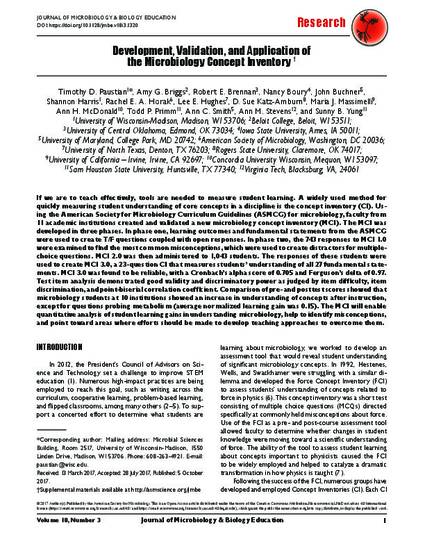
If we are to teach effectively, tools are needed to measure student learning. A widely used method for quickly measuring student understanding of core concepts in a discipline is the concept inventory (CI). Using the American Society for Microbiology Curriculum Guidelines (ASMCG) for microbiology, faculty from 11 academic institutions created and validated a new microbiology concept inventory (MCI). The MCI was developed in three phases. In phase one, learning outcomes and fundamental statements from the ASMCG were used to create T/F questions coupled with open responses. In phase two, the 743 responses to MCI 1.0 were examined to find the most common misconceptions, which were used to create distractors for multiplechoice questions. MCI 2.0 was then administered to 1,043 students. The responses of these students were used to create MCI 3.0, a 23-question CI that measures students’ understanding of all 27 fundamental statements. MCI 3.0 was found to be reliable, with a Cronbach’s alpha score of 0.705 and Ferguson’s delta of 0.97. Test item analysis demonstrated good validity and discriminatory power as judged by item difficulty, item discrimination, and point-biserial correlation coefficient. Comparison of pre- and posttest scores showed that microbiology students at 10 institutions showed an increase in understanding of concepts after instruction, except for questions probing metabolism (average normalized learning gain was 0.15). The MCI will enable quantitative analysis of student learning gains in understanding microbiology, help to identify misconceptions, and point toward areas where efforts should be made to develop teaching approaches to overcome them.
Available at: http://works.bepress.com/nancy-boury/9/

This article is published as Paustian, Timothy D., Amy G. Briggs, Robert E. Brennan, Nancy Boury, John Buchner, Shannon Harris, Rachel EA Horak et al. "Development, validation, and application of the microbiology concept inventory." Journal of microbiology & biology education 18, no. 3 (2017). doi: 10.1128/jmbe.v18i3.1320.